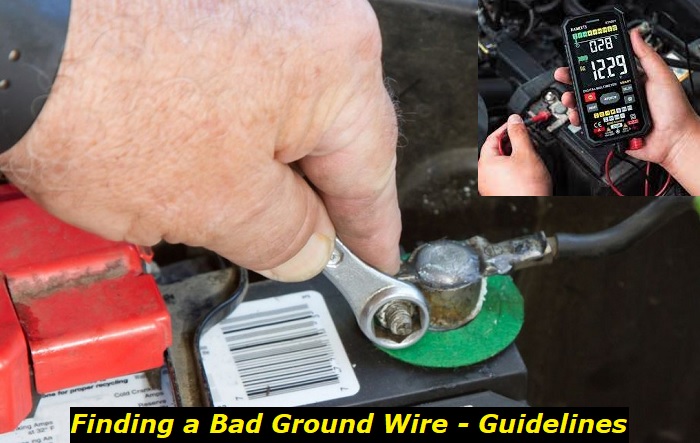To find a bad wire in your car, use a multimeter. Please turn it on, select OHMs, then attach one probe to the battery's negative terminal and the other to the metal point of the car's chassis. Your ground wire is faulty if your multimeter does not read zero ohms.
The process looks straightforward. Not quite. You have to do it systematically and have an in-depth knowledge of how to diagnose that; it is a ground wire problem. It is also good to know how to replace the ground wire if it is defective.
Ground problems highlights
- Level of urgency:high
- DIY inspection:possible
- DIY repairs:possible
- Can you drive?usually, no
- Price of repairs:$0 - $150
- If ignored:low voltage, car glitching heavily
- Ways to fix:clean ground contacts, find a good car electrician

6 Signs your car has a faulty ground wire
Before you embark on using the multimeter to detect a bad ground wire on your car, look out for indicators such as:
1) Flickering or dimming lights
Dimming or flickering of lights are commonly caused by either faulty bulbs or a broken electrical circuit. If the ground wire is worn out or damaged, the electrical circuit will encounter resistance in delivering power to your car's lights. As a result, the lights will start dimming or flickering regularly.
Sometimes, the ground wire may be loose and requires tightening. If that is not the case, and the halogen bulbs have not worn out, take out your multimeter and check for faults on the ground wire.
2) Ignition failure
Several reasons can make your car not start, and one of them is a bad ground wire. A unique indicator that the ground wire is the cause of the problem is the tapping noises you will hear when trying to start the car.
The noise is from the starter solenoid as it opens and closes repeatedly. If the ground wire is faulty, the starter receives less voltage; thus, it cannot start the car.
3) Low battery voltage
Sometimes you experience less powerful electricity in your car than usual. Take your multimeter and measure the voltage from the battery terminals.
You are within the normal range if you get a reading of around 12.6 volts. A reading of 11.5 volts and below indicates a possible ground wire issue. At this point, check on the ground wire using your multimeter.
4) The Engine Control Unit (ECU) malfunction
The ECU is the brain of your car. It relays information that is processed and used for the optimum performance of the engine.
When the current fluctuates due to a faulty ground wire, the ECU relays inaccurate information due to improper data calculation. You may find the fuel indicator rising sharply or the engine behaving abnormally. In such instances, check the ground wire connection.
5) Malfunctions of electrical devices
You may drive on rough terrain and observe the AC or interior lights functioning sporadically - a nightmare.
Don't worry. It could be due to the faulty ground wire impeding the current flow.
6) Dead battery
The ground wire connects the battery to the chassis, thus relaying current to the car. When this wire is faulty, it prevents the alternator from supplying adequate charge to the battery. Eventually, it drains fast, which makes it non-functional.
How to test a faulty ground wire for your car
There is a common but erroneous belief that a car is grounded as long as the ground wire has touched any part of the chassis of a vehicle. Untrue. The ground wire serves you best when you attach it on a paint- and corrosion-free surface of the frame of your car.
How do you ensure that? Using a digital multimeter. Here is the procedure for testing a lousy ground wire using a multimeter:
- Ensure that the ground wire is connected to the battery's negative terminal before you start the test.
- Switch off devices in your car that may consume a lot of electricity from the battery. These are devices like the headlights, audio system, and the AC.
- Turn on the multimeter and set the unit measure at the ohm range (resistance).
- Place one of the probes on the negative terminal of the battery.
- Attach the second probe where the ground wire connects with the chassis or the ground point.
- Check the readings on your multimeter.
- If the reading is above zero, then the ground wire is faulty.
- If the reading is zero, your ground wire is in good condition.
- Check out for terminal and ground point corrosion if the reading deviates from zero by a small margin.
How to replace a defective ground wire on your car
Now, you have tested the ground wire and determined it is faulty. Do you repair it or replace it? I recommend the latter.
It is pretty easy to replace the lousy ground wire if you follow the following steps:
1) Identify the negative terminal of the battery
The battery's negative terminal usually has a black cover and a minus (-) sign next to it. The positive terminal is covered in red and has a plus (+) sign.
2) Remove the faulty ground wire.
Use a wrench to loosen the old ground wire's bolts on the terminal and ground point. Once the bolts are loose, you can remove and discard the old ground wire.
3) Install the new wire and test it.
Strip off the insulation of the new wire and twist it around the terminal and ground point. You can use insulating tape to cover it and the wrench to tighten the bolts. Use the multimeter to test the replaced ground wire, and you are good to go.
Final thoughts
Finding a bad ground wire on your car entails identifying the telltale signs of defective ground wire, testing it, and replacing it. The best method of testing such a wire is using a multimeter. If you observe a low resistance of zero ohms, the wire is good, but anything contrary to that figure indicates a fault.
About the authors
The CarAraC research team is composed of seasoned auto mechanics and automotive industry professionals, including individuals with advanced degrees and certifications in their field. Our team members boast prestigious credentials, reflecting their extensive knowledge and skills. These qualifications include: IMI: Institute of the Motor Industry, ASE-Certified Master Automobile Technicians; Coventry University, Graduate of MA in Automotive Journalism; Politecnico di Torino, Italy, MS Automotive Engineering; Ss. Cyril and Methodius University in Skopje, Mechanical University in Skopje; TOC Automotive College; DHA Suffa University, Department of Mechanical Engineering






Add comment